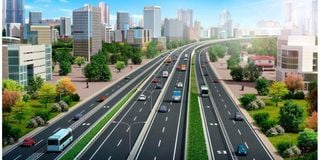
An artist’s impression of the Nairobi-Mau Summit Superhighway. Addressing the infrastructure demand requires more than public resources can muster.
The Nairobi-Nakuru-Mau- Mau Summit corridor is one of the biggest threats to the life and limb of the hundreds of thousands of citizens like me who drive on this route every other day. Never before have we witnessed such levels of chaos and gridlock on this highway. Last week, travellers were being advised to stockpile food items before starting the journey.
Compounding the problem for motorists and travellers is the fact that the main alternative route- the road passing through the escarpment to - Mai Mahiu – and Narok- is similarly treacherous especially as you drive along the escarpment section.
Today; in terms of comfort and peace of mind; it is cheaper to travel to Kisumu and Kakamega. Eldoret or Kisii by air than to drive a personal car through what we call the Northern Corridor.
It is a pity because as we all know, the Northern Corridor is what connects Kenya to its key export markets in Uganda, Rwanda Burundi, and Democratic Republic of Congo and to the markets within the Comesa trading bloc.
Our transporters are incurring huge losses, especially in terms of turnaround time due to the heavy traffic in this key economic corridor.
20,000 vehicles
Statistics from the Kenya National Highway Authority show that the Nairobi-Nakuru-Mau Summit corridor carries an estimated 20,000 vehicles a day on a normal day. The authority estimates that vehicle traffic has been increasing at an annual rate of four per cent.
The mess in this critical economic corridor is a prime example of the government’s incompetent approach to infrastructure planning. Way back in 2018, the government rolled out a plan to implement what was going to be the most ambitious attempt at dealing with the perennial congestion on this key and critical section of the Northern Corridor.
Under that plan, the scope of the construction was to include widening the road construction, building a four-kilometre viaduct through Nakuru Town and building multiple interchanges along the 233 km highway.
The current two-lane highway was to be expanded into a four-lane dual carriageway that would be expanded further into six-lane dual carriageways at busy sections.
Why did the big plan fail? First, the government did not have the money and decided to go through the Public-Private Partnership (PPP) route. This project was not procured under the privately initiated model but was competitively procured with Vinci Highway Group of France, beating a consortium led by the Portuguese construction company, Mota Engil. The arrangement was that the French company would build the road for us with its own finances, take ownership and control of the highway for 30 years, and finally revert ownership to the state.
Influential backers
Secondly, politics. When the regime of former President Uhuru Kenyatta exited, the project lost the backing of well-connected networks under that regime. In Kenya; PPP projects evoke high-octane politics. Having powerful and influential backers is critical to the success of a PPP project of this size and scope.
The third reason, the lack of capacity to negotiate and roll out PPP projects on time and at the right price. During the negotiation stages; it emerged that the French construction company had come up with a model whereby it would procure EPC contractors at very expensive rates. The toll tariffs were going to be too expensive for users. The project collapsed.
As things stand, it seems to me that the government does not have any major plans to sort out the mess in this critical economic corridor.
During a recent visit to Bejing, media reports said President William Ruto had discussed the project with the Chinese. Yet as we all know; the Chinese have little appetite for large PPP’. The likelihood is that they will insist on a normal EPC contract funded by their export credit and policy banks such as China Eximbank. We have no room to take more Chinese loans.
Just the other day, a credible source and player in the PPP space whispered to me that the Portuguese group- Mota Engil had recently expressed interest and was planning to table a privately initiated proposal to the government.
This should not surprise me because the Portuguese group spend a lot of money on designs and preparatory work when they competed with the Vinci Group for this project in 2018.
Our policymakers forget that capitalism cannot function efficiently in an economy with bad roads, congested ports, expensive electricity and an efficient railway system.
How I miss the days of Mwai Kibaki. In the budget for the financial year that ended 2007, the gross development budget for roads increased from Sh17.7 billion to Sh32 billion, an increase of 85 percent within one fiscal year.













